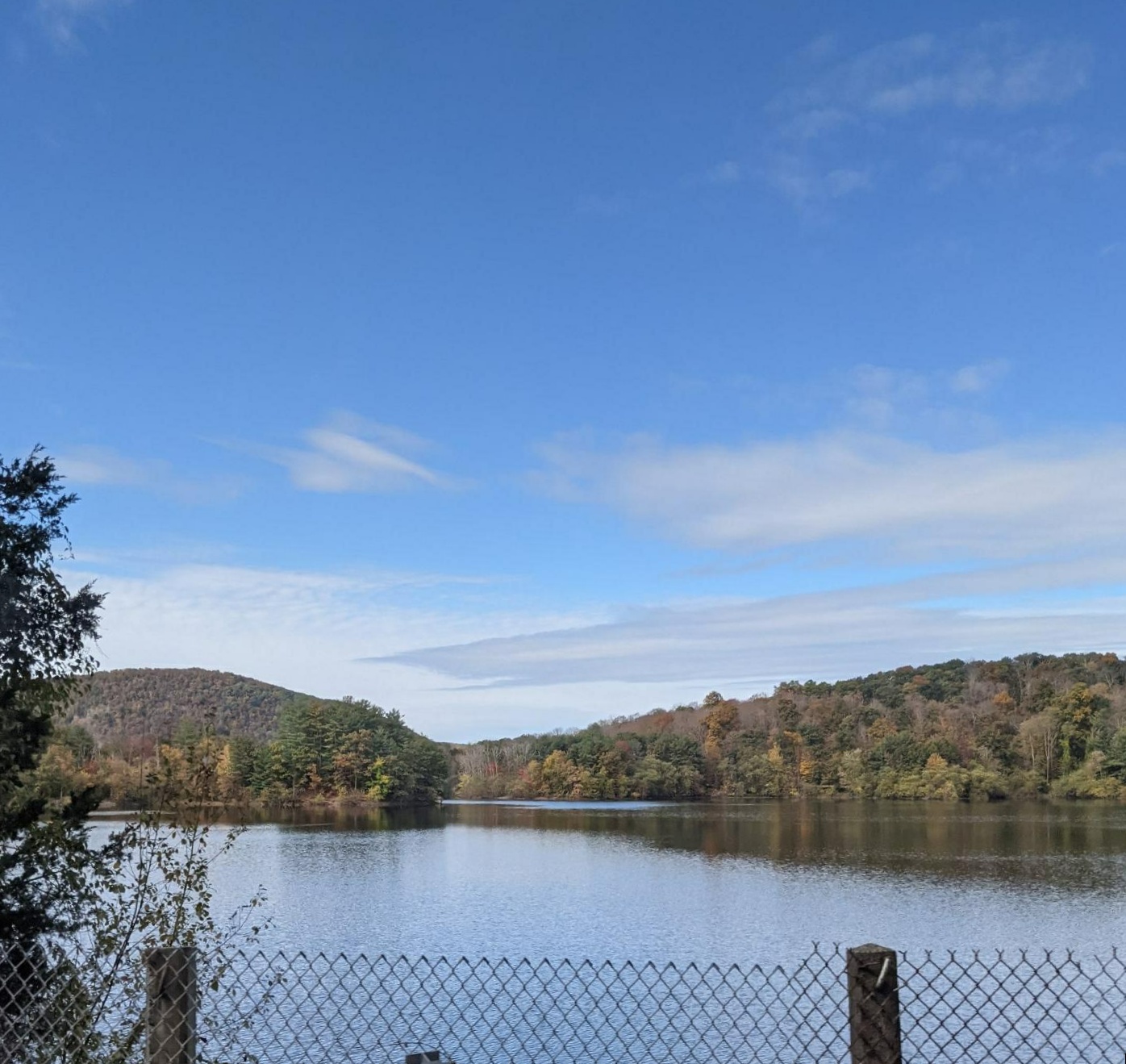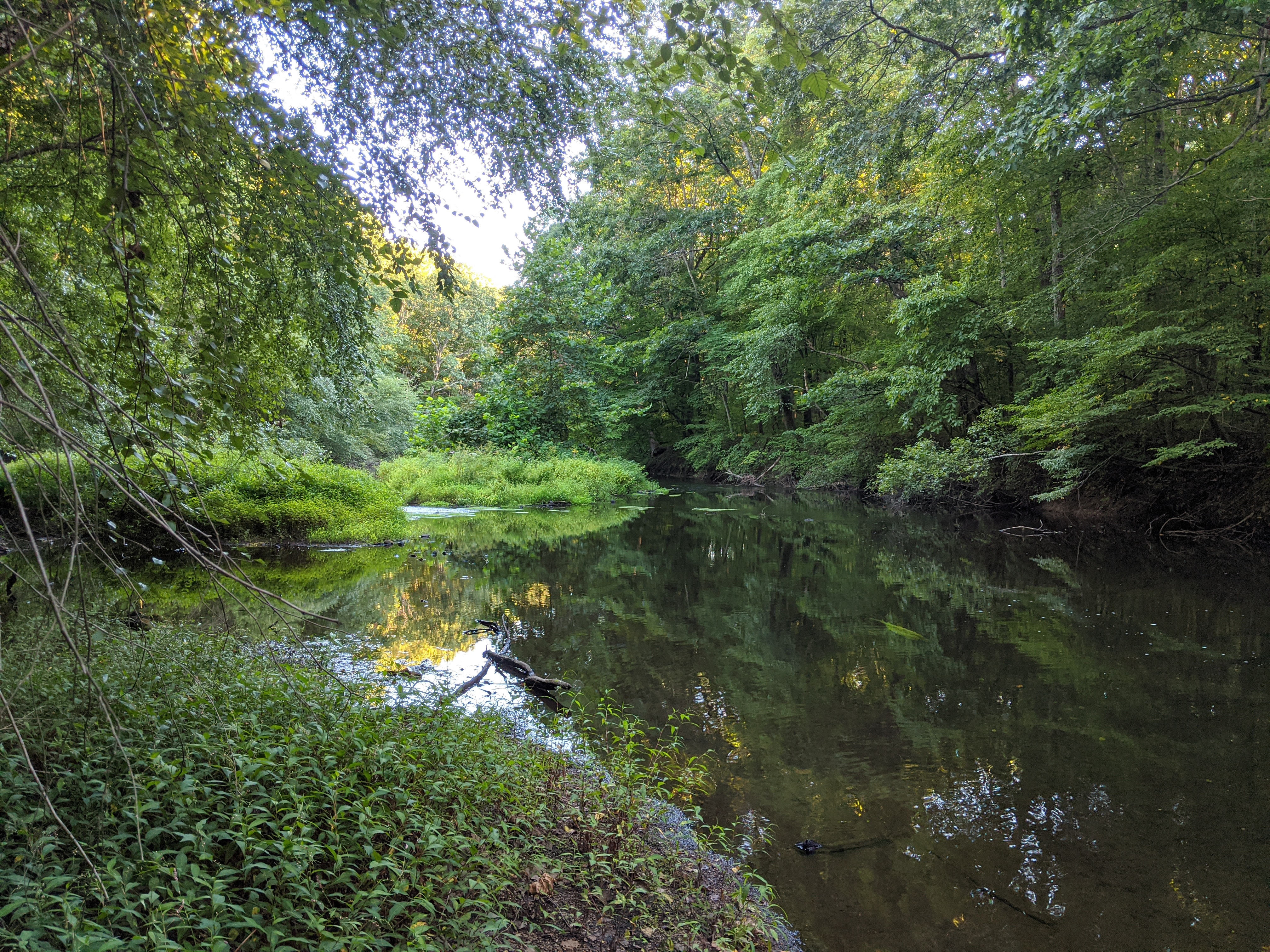|
Wanaque Reservoir
Wanaque Reservoir is a man-made lake located within Wanaque and Ringwood, New Jersey along the Wanaque River. The reservoir came into being in 1928 by the construction of the Raymond Dam along the river in Wanaque. Besides the Wanaque River, the reservoir receives water from two diversions: the Pompton Lakes intake, which takes water from the Ramapo River, and the Two Bridges intake, which takes water from the Pompton River. It is the second largest reservoir in New Jersey by volume, after Round Valley Reservoir. It is the second largest body of water in New Jersey by area, after Lake Hopatcong Lake Hopatcong is the largest freshwater body in New Jersey, United States, about in area. Located from the Delaware River and from Manhattan, New York City, the lake forms part of the border between Sussex and Morris counties in the state's .... Construction Construction of the Wanaque Reservoir represented a significant achievement in enabling the supply of potable water t ... [...More Info...] [...Related Items...] OR: [Wikipedia] [Google] [Baidu] |
Ramapo Mountain State Forest
Ramapo Mountain State Forest is a state forest in Bergen and Passaic Counties in New Jersey. The park is operated and maintained by the New Jersey Division of Parks and Forestry. The park offers hiking, hunting, canoeing, fishing (including ice fishing), cross-country skiing, horseback riding and mountain biking. Several trails lead to views of the New York City skyline. The Ramapo Lake Natural Area within the park has several trails to excellent views from rock outcroppings and ledges. A mountain lake provides fishing and birdwatching (but no swimming). The forest borders the Ramapo Valley County Reservation, a part of the Bergen County park system, and Ringwood State Park in Bergen and Passaic counties. It is part of a trail system which runs along the ridge of the Ramapo Mountains north through Mahwah, New Jersey and into Rockland County, New York. The forest contains the ruins of Van Slyke Castle, a popular destination for hikers. History In the 1920s Clifford Mac ... [...More Info...] [...Related Items...] OR: [Wikipedia] [Google] [Baidu] |
Reservoir
A reservoir (; from French ''réservoir'' ) is an enlarged lake behind a dam. Such a dam may be either artificial, built to store fresh water or it may be a natural formation. Reservoirs can be created in a number of ways, including controlling a watercourse that drains an existing body of water, interrupting a watercourse to form an embayment within it, through excavation, or building any number of retaining walls or levees. In other contexts, "reservoirs" may refer to storage spaces for various fluids; they may hold liquids or gasses, including hydrocarbons. ''Tank reservoirs'' store these in ground-level, elevated, or buried tanks. Tank reservoirs for water are also called cisterns. Most underground reservoirs are used to store liquids, principally either water or petroleum. Types Dammed valleys Dammed reservoirs are artificial lakes created and controlled by a dam A dam is a barrier that stops or restricts the flow of surface water or underground streams ... [...More Info...] [...Related Items...] OR: [Wikipedia] [Google] [Baidu] |
Wanaque River
The Wanaque River ( Native American for "place of the sassafras") is a tributary of the Pequannock River in Passaic County in northern New Jersey in the United States.Gertler, Edward. ''Garden State Canoeing'', Seneca Press, 2002. Once known as the Long Pond River, the source of the Wanaque River is Greenwood Lake, once known as Long Pond (not to be confused with the nearby village of Greenwood Lake in the state of New York). Both Greenwood Lake and the surrounding Sterling Forest watershed straddle the border of the states of New Jersey and New York. Downstream, the construction of dams at Monks and Wanaque created the Monksville and Wanaque reservoirs, respectively. From the Raymond Dam of the Wanaque Reservoir, the river flows to its confluence with the Pequannock River. See also *List of rivers of New Jersey This is a list of streams and rivers of the U.S. state of New Jersey. List of New Jersey rivers includes streams formally designated as rivers. There are al ... [...More Info...] [...Related Items...] OR: [Wikipedia] [Google] [Baidu] |
Ramapo River
The Ramapo River is a tributary of the Pompton River, approximately 30 mi (48 km) long, in southern New York and northern New Jersey in the United States. Course The Ramapo river rises in Round Lake, a small freshwater lake in the Town of Monroe, New York, in a mountainous area of central Orange County, New York. It flows southeast through the village, where the river was dammed in 1741 for a sawmill and grist mill. It continues to Harriman, where a chemical plant, Nepera Chemical, was built. While the plant has been dismantled, a superfund site has been designated at the location where barrels of toxic chemicals were buried. At Harriman, the river turns south into western Rockland County, where it flows through the hamlet and town of Ramapo, New York, then into northern Bergen County, New Jersey. In New Jersey, it flows SSW along the east side of the ridge of the Ramapo Mountains. The river flows into Potash Lake in Oakland, and from there into Pompton Lake in Pompto ... [...More Info...] [...Related Items...] OR: [Wikipedia] [Google] [Baidu] |
Pompton River
The Pompton River is a tributary of the Passaic River, approximately long, in northern New Jersey in the United States. It is formed south of the borough of Pompton Lakes by the confluence of the Ramapo and Pequannock rivers. It flows south, passing between Lincoln Park and Pequannock Township (to the west) and Wayne (to the east). It enters the Passaic north of Fairfield. Its watershed encompasses a section of the Ramapo Mountains along the New York-New Jersey border in the rural suburbs of New York City. It is the main tributary by volume of the Passaic. A portion of the river's water is diverted to the nearby Wanaque Reservoir. Tributaries * Pequannock River * Ramapo River See also *List of rivers of New Jersey This is a list of streams and rivers of the U.S. state of New Jersey. List of New Jersey rivers includes streams formally designated as rivers. There are also smaller streams (''i.e.,'' branches, creeks, drains, forks, licks, runs, etc.) in the ... * Pompt ... [...More Info...] [...Related Items...] OR: [Wikipedia] [Google] [Baidu] |
Ringwood, New Jersey
Ringwood is a borough in Passaic County, New Jersey, United States. As of the 2020 United States census, the borough's population was 11,735, a decline of 493 (−4.0%) from the 2010 census count of 12,228,DP-1 - Profile of General Population and Housing Characteristics: 2010 for Ringwood borough, Passaic County, New Jersey , . Accessed March 14, 2012. [...More Info...] [...Related Items...] OR: [Wikipedia] [Google] [Baidu] |
Wanaque, New Jersey
Wanaque () is a borough in Passaic County, New Jersey, United States. As of the 2010 United States Census, the borough's population was 11,116,DP-1 - Profile of General Population and Housing Characteristics: 2010 for Wanaque borough, Passaic County, New Jersey , . Accessed August 30, 2012. [...More Info...] [...Related Items...] OR: [Wikipedia] [Google] [Baidu] |
Passaic County, New Jersey
Passaic County ( ) is a county in the U.S. state of New Jersey that is part of the New York metropolitan area. As of the 2020 United States census, the population of Passaic County was enumerated at 524,118, an increase of 22,892 (4.6%) from the 501,226 counted at the 2010 U.S. census,DP-1: Profile of General Population and Housing Characteristics: 2010; 2010 Demographic Profile Data for Passaic County, New Jersey . Accessed January 13, 2013. in turn an increase of 12,177 ... [...More Info...] [...Related Items...] OR: [Wikipedia] [Google] [Baidu] |
New Jersey
New Jersey is a state in the Mid-Atlantic and Northeastern regions of the United States. It is bordered on the north and east by the state of New York; on the east, southeast, and south by the Atlantic Ocean; on the west by the Delaware River and Pennsylvania; and on the southwest by Delaware Bay and the state of Delaware. At , New Jersey is the fifth-smallest state in land area; but with close to 9.3 million residents, it ranks 11th in population and first in population density. The state capital is Trenton, and the most populous city is Newark. With the exception of Warren County, all of the state's 21 counties lie within the combined statistical areas of New York City or Philadelphia. New Jersey was first inhabited by Native Americans for at least 2,800 years, with the Lenape being the dominant group when Europeans arrived in the early 17th century. Dutch and Swedish colonists founded the first European settlements in the state. The British later seized control o ... [...More Info...] [...Related Items...] OR: [Wikipedia] [Google] [Baidu] |
Lake
A lake is an area filled with water, localized in a basin, surrounded by land, and distinct from any river or other outlet that serves to feed or drain the lake. Lakes lie on land and are not part of the ocean, although, like the much larger oceans, they do form part of the Earth's water cycle. Lakes are distinct from lagoons, which are generally coastal parts of the ocean. Lakes are typically larger and deeper than ponds, which also lie on land, though there are no official or scientific definitions. Lakes can be contrasted with rivers or streams, which usually flow in a channel on land. Most lakes are fed and drained by rivers and streams. Natural lakes are generally found in mountainous areas, rift zones, and areas with ongoing glaciation. Other lakes are found in endorheic basins or along the courses of mature rivers, where a river channel has widened into a basin. Some parts of the world have many lakes formed by the chaotic drainage patterns left over from the la ... [...More Info...] [...Related Items...] OR: [Wikipedia] [Google] [Baidu] |
Round Valley Reservoir
The Round Valley Reservoir in Clinton Township in Hunterdon County, New Jersey, United States, was formed in 1960 when the New Jersey Water Authority constructed two large dams and flooded a large valley. The reservoir is named after the naturally formed circular valley surrounded by Cushetunk Mountain. The deep valley was caused by erosion of the soft sedimentary rock. The surrounding ridges of Cushetunk Mountain endure because they were underlaid with dense and durable volcanic rock diabase that cooled slowly under the surface of the earth. The reservoir covers what used to be a farming community, with remains of a school and a church on the lake floor among other buildings. Reaching depths of , this reservoir is best known for its pristine clear blue waters. The reservoir contains of water for use in central New Jersey, making it the largest in the state. Its water is distributed during times of drought via the nearby south branch of the Raritan River. The New Jersey Div ... [...More Info...] [...Related Items...] OR: [Wikipedia] [Google] [Baidu] |
Lake Hopatcong
Lake Hopatcong is the largest freshwater body in New Jersey, United States, about in area. Located from the Delaware River and from Manhattan, New York City, the lake forms part of the border between Sussex and Morris counties in the state's northern highlands region. Lake Hopatcong was produced by damming and flooding of two ponds, known as the Great Pond and Little Pond, and the Musconetcong River, its natural outlet. Historically known as a resort lake for vacationing New Yorkers, it is now a mostly suburban residential lake. Name The exact origin of the name Hopatcong is unknown, though it is most commonly attributed to the Lenape Indian word for "stone water," or "stone over water". Some linguists believe "Hopatcong" to be a derivative of the Lenape word ''hapakonoesson'', meaning "pipe stone". One explanation of the origin of the word ''Hopatcong'' is that it was a derivation from the Lenni Lenape word ''Huppakong'' meaning "honey waters of many coves," but this wording ... [...More Info...] [...Related Items...] OR: [Wikipedia] [Google] [Baidu] |






